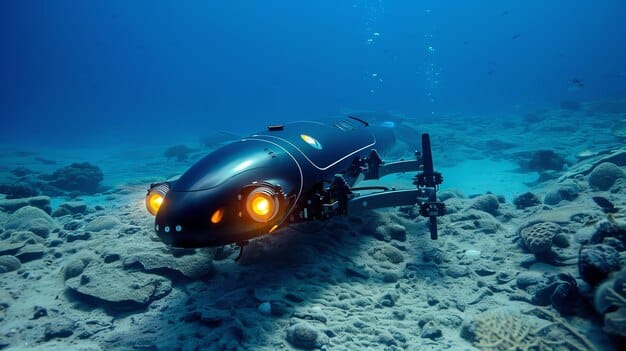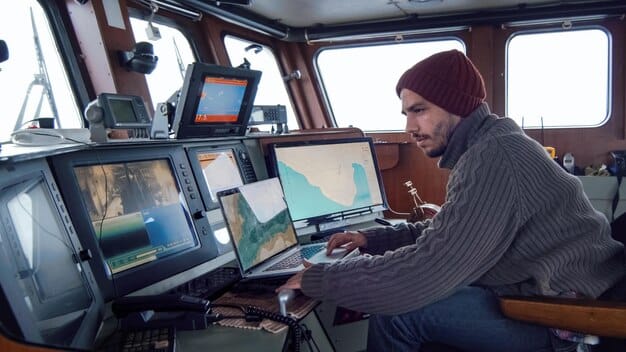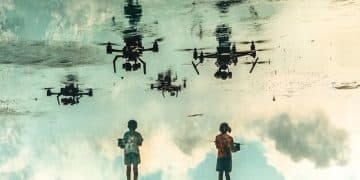US Military’s Autonomous Underwater Vehicle Development for Naval Ops

The US military actively develops autonomous underwater vehicles (AUVs) to enhance naval operations by providing capabilities for reconnaissance, mine countermeasures, anti-submarine warfare, and covert intelligence gathering, revolutionizing undersea combat and exploration.
In an era of increasingly complex geopolitical landscapes and technological advancements, the underwater domain has emerged as a crucial frontier for military capabilities. The United States military is pioneering the development of autonomous underwater vehicles for naval operations, transforming how missions are conducted beneath the waves. These uncrewed systems promise to redefine naval strategy, offering unprecedented flexibility, persistence, and discretion.
The Strategic Imperative for Autonomous Underwater Vehicles (AUVs)
The US Navy’s push into autonomous underwater vehicles isn’t merely about technological novelty; it’s a strategic necessity driven by evolving threats and the imperative to maintain a competitive edge in a contested maritime environment. Traditional submarine operations are expensive and carry significant human risk. AUVs offer a cost-effective, scalable, and often stealthier alternative for a range of missions currently performed by crewed vessels.
These underwater drones are designed to operate for extended periods without direct human intervention, reducing the strain on personnel and resources. Their small size and reduced acoustic signature make them ideal for covert operations in areas where larger, crewed assets might be detected. Furthermore, advancements in artificial intelligence and machine learning are rapidly increasing their autonomy and decision-making capabilities.
Enhanced Intelligence, Surveillance, and Reconnaissance (ISR) Capabilities
AUVs are proving invaluable for intelligence gathering in contested or denied waters. Their ability to loiter silently for days or weeks provides continuous data collection where traditional methods are too risky or impractical.
- Covert Data Collection: AUVs can approach adversary coastlines or critical choke points undetected to gather real-time intelligence.
- Environmental Mapping: They map seafloors, identify potential choke points, and collect hydrographic data vital for safe navigation and mission planning.
- Persistent Presence: Unlike manned submarines that require crew rotation and resupply, AUVs can maintain a surveillance posture for extended durations.
The data collected by these platforms can range from acoustic signatures of potential threats to visual imagery of undersea infrastructure. This rich, continuous stream of information is crucial for informed decision-making and pre-emptive actions, offering a significant advantage in the strategic undersea competition.
Mine Countermeasures (MCM) Operations
Mine warfare remains a significant threat to naval operations, capable of denying access to critical sea lanes and ports. Traditionally, MCM operations are dangerous, slow, and place human divers or crewed ships at direct risk. AUVs are fundamentally transforming this hazardous domain.
The shift towards uncrewed systems for MCM provides a safer and more efficient means of detecting, classifying, and neutralizing underwater explosive devices. These autonomous vehicles can systematically sweep large areas, identifying objects of interest and, in some cases, even deploying neutralization charges without putting human lives in harm’s way. This autonomy accelerates the process of clearing paths for naval vessels, ensuring freedom of navigation.
- Reduced Human Risk: Removing personnel from hazardous minefields is the primary benefit, making MCM operations safer.
- Increased Speed and Efficiency: AUVs can cover vast areas more quickly and systematically than traditional methods.
- Enhanced Detection Technologies: Equipped with advanced sonar and optical sensors, they can differentiate between various underwater objects.
This evolving capability signifies a significant leap in protecting naval assets and maintaining open maritime trade routes, underscoring the indispensable role AUVs are beginning to play in modern naval warfare strategies.

Key Development Programs and Prototypes
The US military’s dedication to AUV development is evident in numerous unclassified programs and prototypes, each addressing specific operational needs. These programs often leverage cutting-edge commercial technologies while adapting them for military robustness and mission-specific requirements. Collaboration between government laboratories, academic institutions, and defense contractors is pivotal in accelerating this development.
These initiatives focus not only on developing the vehicles themselves but also on the necessary supporting infrastructure, such as launch and recovery systems, data processing capabilities, and advanced command and control interfaces. The goal is to create a seamless ecosystem where AUVs can be integrated into existing naval fleets and operate effectively in diverse maritime environments.
The Large Displacement Unmanned Undersea Vehicle (LDUUV)
The LDUUV, also known as the Orca Extra Large Unmanned Undersea Vehicle (XLUUV), represents a significant leap forward in autonomous long-endurance capabilities. Designed to be modular and highly adaptable, the Orca is intended for extended missions without human intervention.
This platform aims to provide the Navy with an unprecedented ability to conduct sustained operations in contested waters, performing tasks that require significant payload capacity and range. Its large size allows it to carry various modular payloads, making it suitable for multiple mission sets from intelligence gathering to mine laying.
- Extended Endurance: Capable of operating for months at a time, providing persistent presence.
- Modular Payload Bay: Can be configured for different missions by swapping out mission-specific modules.
- Stealth Capabilities: Designed to operate covertly, making it difficult for adversaries to detect.
The Orca XLUUV’s development underscores the Navy’s commitment to shifting away from purely manned platforms for certain high-risk or long-duration missions, allowing crewed submarines to focus on more complex, deep-strike operations.
Small and Medium UUVs: Versatility and Swarm Capabilities
Beyond the large Orca, the US military is also heavily invested in developing smaller, more versatile AUVs. These range from man-portable systems to medium-sized vehicles that can be launched from various platforms, including surface ships and manned submarines. Their strength lies in their numbers and ability to operate in coordinated swarms.
Examples include the REMUS (Remote Environmental Measuring UnitS) series, widely used for mine countermeasures and hydrographic surveys, and various experimental platforms exploring new sensor technologies and autonomous behaviors. These smaller UUVs offer tactical flexibility, allowing for distributed operations and rapid deployment.
- Scalability: Deployable in large numbers for distributed tasks.
- Maneuverability: Smaller size allows operation in confined or shallow waters.
- Cost-Effectiveness: Lower production and operational costs compared to larger platforms.
The concept of AUV swarms, where multiple vehicles collaborate to achieve a mission objective, is particularly promising. Such swarms could overwhelm adversary defenses, rapidly map large areas, or perform complex search patterns more efficiently than a single, larger asset. This distributed approach enhances both resilience and operational effectiveness in varied maritime environments.
Challenges and Ethical Considerations
While the promise of AUVs for naval operations is immense, their development is not without significant technical, operational, and ethical challenges. Overcoming these hurdles is crucial for their successful integration into future naval forces. Technical issues revolve around power sources, reliable communication underwater, and advanced navigation in GPS-denied environments. Operational challenges include maintaining these complex systems in harsh marine conditions and developing human-machine teaming protocols.
Beyond the engineering aspects, the ethical implications of increasingly autonomous military systems are a major point of discussion. As AUVs gain more decision-making capabilities, questions arise about accountability, unintended consequences, and the boundaries of human control in combat scenarios. These considerations are shaping policy and research directions, emphasizing a responsible approach to autonomy. Navigating these complexities requires careful planning, rigorous testing, and continuous dialogue among stakeholders.
Power and Endurance Limitations
One of the most persistent technical challenges for AUVs is power. Operating underwater requires significant energy for propulsion, sensors, and communication. Traditional battery technologies often limit mission endurance, especially for longer-duration deployments. The need for frequent recharging or battery replacement can compromise covertness and operational efficiency.
Researchers are exploring various solutions to extend endurance, including more efficient propulsion systems, advanced battery chemistries (like lithium-ion and fuel cells), and even unconventional power sources such as thermal energy conversion or ambient current harvesting. The goal is to enable AUVs to remain deployed for weeks or even months without needing to resurface or return to a mothership, maximizing their operational utility.
- Battery Technology: Developing higher energy density batteries is critical for extended missions.
- Alternative Power Sources: Investigating fuel cells, thermal gradients, and even nuclear micro-reactors for larger platforms.
- Energy Harvesting: Exploring ways for AUVs to scavenge energy from ocean currents or temperature differences.
Solving the power problem is fundamental to unlocking the full potential of AUVs, enabling true long-term persistence in the underwater domain for a wide array of naval applications.
Navigation, Communication, and Autonomy in a Denied Environment
Underwater environments present unique challenges for navigation and communication. GPS signals do not penetrate water, forcing AUVs to rely on alternative methods such as inertial navigation systems (INS), Doppler Velocity Logs (DVL), and acoustic positioning systems. These methods can suffer from drift over long missions, requiring periodic updates from surface assets or pre-surveyed landmarks.
Communication underwater is similarly challenging; traditional radio frequencies are ineffective, necessitating acoustic modems which offer low bandwidth and are susceptible to detection. Developing robust, low-observable communication methods is vital for tasking AUVs and retrieving their data. Furthermore, enhancing true autonomy – enabling AUVs to make complex decisions and adapt to unforeseen circumstances without human override – is a significant focus of current research, particularly for operations in denied or communications-restricted areas.
- GPS-Denied Navigation: Improving INS accuracy and developing new acoustic or geomagnetic navigation techniques.
- Underwater Communications: Researching high-bandwidth, covert acoustic or optical communication systems.
- Cognitive Autonomy: Developing AI algorithms that allow AUVs to adapt mission parameters and handle unexpected events independently.
These technological advancements are essential to ensure AUVs can operate effectively and reliably in the most challenging and hostile underwater environments, providing the US Navy with truly self-sufficient and capable undersea assets.

Future Outlook and Integration into Naval Doctrine
The trajectory of AUV development suggests a future where these uncrewed systems will be fully integrated into naval operations, complementing and, in some cases, replacing crewed platforms for specific missions. The US Navy envisions a layered approach to undersea warfare, where large, crewed submarines operate alongside fleets of smaller, more numerous AUVs, each contributing to a comprehensive picture of the underwater battlespace. This future force will be more distributed, resilient, and capable of operating across a wider spectrum of conflict.
This integration will require significant shifts in naval doctrine, training, and logistics. Personnel will need new skillsets to manage and exploit the data generated by AUVs, and logistical chains will adapt to deploy and recover these systems globally. The long-term vision is to establish a truly dynamic and adaptive undersea force, where human and machine collaborate seamlessly to achieve strategic objectives.
Developing Human-Machine Teaming and Trust
As AUVs become more sophisticated, the relationship between human operators and autonomous systems will evolve from direct control to supervision and collaboration. Building trust in autonomous decision-making is critical, especially when systems are tasked with performing complex or critical missions. This involves designing intuitive human-machine interfaces, establishing clear lines of authority, and ensuring reliable system performance in all conditions.
Training scenarios will increasingly simulate complex AUV deployments, allowing operators to understand system limitations, interpret autonomous behaviors, and intervene effectively when necessary. The aim is to create resilient teams where humans provide strategic oversight and cognitive flexibility, while AUVs handle repetitive, dangerous, or long-duration tasks.
- Intuitive Interfaces: Designing user-friendly systems for mission planning, monitoring, and data analysis.
- Operator Training: Developing advanced curricula for managing and collaborating with autonomous fleets.
- Trust Building: Ensuring transparency in AUV algorithms and predictable behavior in varied scenarios.
The success of future naval operations critically depends on achieving a symbiotic relationship between advanced AUVs and their human counterparts, fostering a new era of naval warfare predicated on intelligent automation and skilled oversight.
Addressing International Regulations and Arms Control
The proliferation of AUV technology, particularly those with potential offensive capabilities, raises complex questions concerning international law and arms control. There is an ongoing global dialogue about how existing maritime laws apply to autonomous systems, especially regarding concepts like “innocent passage” or identification in international waters. Furthermore, the development of weaponized AUVs necessitates discussions on arms control treaties and safeguards to prevent unintended escalation.
The US military is engaging with international partners and legal experts to navigate these uncharted waters, advocating for responsible development and deployment of AUVs. Transparency, adherence to ethical guidelines, and international cooperation are key to ensuring that these powerful new technologies contribute to security and stability, rather than fostering new forms of conflict or proliferation risks in the global maritime domain.
- Legal Frameworks: Establishing international consensus on the legal status and operational rules for military AUVs.
- Arms Control Discussions: Engaging in dialogues to prevent an uncontrolled arms race in autonomous underwater systems.
- Ethical Standards: Promoting the responsible development and use of AUVs, particularly concerning lethal autonomy.
These discussions are vital to shaping a future where AUVs enhance global security without creating new diplomatic or ethical dilemmas, ensuring their integration is both effective and responsible on the world stage.
| Key Area | Brief Description |
|---|---|
| 🚀 Strategic Imperative | AUVs are essential for maintaining naval advantage, reducing human risk, and providing scalable, stealthy capabilities for various missions. |
| 🛠️ Key Development Programs | Programs like the Orca XLUUV focus on long-endurance, modular platforms, while smaller UUVs enable versatile swarm operations. |
| ⚠️ Challenges & Ethics | Overcoming power limitations, communication hurdles, developing true autonomy, and addressing ethical implications are critical. |
| 🌐 Future Integration | Future naval doctrine will see seamless human-machine teaming and a distributed undersea force; international regulations are key. |
Frequently Asked Questions About US Military AUVs
The US Navy primarily deploys AUVs for intelligence, surveillance, and reconnaissance (ISR), mine countermeasures (MCM), anti-submarine warfare (ASW), and various forms of oceanographic data collection. Their autonomy provides prolonged presence in hazardous or denied environments.
AUVs operate in dangerous zones—such as minefields or contested waters—reducing the need for human personnel. This minimizes casualties and allows crewed vessels to focus on higher-level strategic operations, increasing overall safety and operational efficiency.
An Extra Large Unmanned Undersea Vehicle (XLUUV), like the Orca, is a large, long-endurance AUV with significant payload capacity. It’s crucial because it enables extended, covert missions, potentially carrying various sensors or even weapons, expanding the Navy’s reach and capability without risking personnel.
Key hurdles include extending power and endurance for long missions, ensuring reliable communication in challenging underwater environments, and developing advanced navigation systems that don’t rely on GPS. Advancing true autonomy for complex decision-making is also a significant challenge.
AUVs will be integrated as complements to crewed vessels, forming a distributed and layered undersea force. This includes developing human-machine teaming protocols, updating naval doctrine, and establishing international regulations to ensure responsible and ethical deployment.
Conclusion
The development of autonomous underwater vehicles by the US military marks a transformative shift in naval operations. These systems are moving beyond experimental phases to become indispensable assets, providing unparalleled intelligence, reconnaissance, and mine countermeasures capabilities, all while significantly reducing human risk. While challenges like power, communication, and ethical considerations persist, ongoing research and strategic investments underscore a commitment to a future naval force where human innovation and robotic precision combine to maintain a decisive edge in the complex undersea domain. The increasing sophistication and integration of AUVs will undoubtedly reshape global naval strategy for decades to come, ensuring the US Navy remains at the forefront of maritime power.





